
|
Lesson Four
by Dr Jamie Love |

|
 and
and  licensed under a Creative Commons Attribution-ShareAlike 4.0 International License.
licensed under a Creative Commons Attribution-ShareAlike 4.0 International License.

|
Lesson Four
by Dr Jamie Love |

|
Before we discuss meiosis, it is important that we first cover some ideas about chromosomes, sets of chromosomes and how we think about them in nuclear division.
"Normal" cells contain two full sets of chromosomes
and are described as diploid. ("Diploos" is Greek
for "double".)
Diploid is often abbreviated as 2n to remind us that it
is "double".
Most of your cells are diploid - they contain two sets of chromosomes.
Each set (n) of human chromosomes contains 23 chromosomes
so most cells in your body have 46 chromosomes.
However, there is one kind of cell that is not diploid
and that you must completely understand. Mature gametes, the sex cells
(sperm and egg), have only one full set of chromosomes. Cells with
only one set of chromosomes are called haploid. ("Haploeides"
is Greek for "single".)
I like to remind myself that "haploid" sounds like
"half-load", but don't take that literally! Haploid
is a single set of chromosomes, not a half set.
Haploid is often abbreviated as 1n to remind us there's
only one set of chromosomes in that cell. This is usually shortened
to merely n.
Ploidy, the number of chromosomes in a cell, is very important
in genetics so keep track of the chromosome numbers.
During mitosis one mother nucleus makes two identical daughter
nuclei. That means that when a diploid cell (2n) undergoes mitosis
and cytokinesis it produces two diploid cells (each also of 2n).
Now that you understand the "chromosome counting", from
the last lesson, you understand how that happens. It's due to
the way the two kinetochores become centromeres and thus turn
the chromatids into chromosomes. But you knew that! 
An incorrect number of chromosomes, caused by an incomplete set
(n) or extra chromosomes, is called an aneuploidy. Some
diseases are caused by having an incorrect number of chromosomes.
Down syndrome is caused by having one extra chromosome (chromosome
#21) so people with Down syndrome have 47 chromosomes. Most cancerous
cells carry many extra chromosomes and some are even polyploid.
Polyploidy ("poly" is Greek for "many")
is a special kind of ploidy. It means there are extra SETS of
chromosomes not just some extra chromosomes. A cell with 3n,
4n, 5n, or any integer of n (indicating a complete set of chromosomes)
is a polyploid cell.
|
There are some exceptions to "anything other than 46
is bad " in humans but you don't have to know them for
this course. However, you may come across them in other courses
and I wouldn't want you to think they are diseases.
None of your circulating red blood cells (RBCs) have a nucleus so they have no chromosomes. This has to do with the way RBCs "mature". Indeed, any circulating RBC that has chromosomes is very likely a sign of an RBC cancer! At the opposite extreme, some specialized cells are created by the "merger" or fusion of cells - the reverse of cytokinesis. That creates a cell with extra nuclei and therefore extra sets of chromosomes. Most of your muscle cells are multinucleated. So are your osteoblasts (specialized cells that lay down the protein matrix of your bones). They are normal, natural, healthy polyploid cells. Again, don't memorize those cell exceptions. I just want you to be aware that they happen, naturally, to certain cells and are not the cause of a disease. |
The above definitions and information will help you to understand
mitosis, meiosis and the complications we will discuss, so be
sure you understand them. OK, that's enough background - let's
get on with meiosis. But first a word about mitosis! 
| Mitosis is often called "copy division" because the genetic material is copied. |

|
Meiosis has some similarities to mitosis and that will make it
easier to learn meiosis. But meiosis has some very important differences
too and they make meiosis very special.
During meiosis and the cytokinesis that follow, one diploid mother
cell (2n) makes four unique daughter cells and they
are all haploid (1n)! 
|
Meiosis is often called "reduction division" because
the genetic material is reduced - by half.
Meiosis is extremely important not only for sexual reproduction, but also for creating the diversity upon which natural selection operates. |

|
Sexual reproduction combines the genetic information from
two different cells that are usually from two different individuals.
Each parent contributes a haploid (n) gamete (sex cell). These
two gametes, a female egg and a male sperm, fuse to produce a
genetically unique single cell called a zygote. The zygote
is diploid (2n) having combined the genetic information provided
by the gametes (n) of both parents.
In a very real genetic sense,
all offspring of sexual reproduction are "half identical"
to each parent!
Note that if diploid (2n) cells were fused the "zygote"
would have FOUR sets of chromosomes. It would be 4n! [That's called
a "tetraploid" cell, but you don't have to know that.]
Although this sometimes happens among plants, it is deadly for
humans. [Why? Well, it has to do with the genetic regulation and management
of all the extra materials. Just think of it as too much of a
good thing.]
If it were not for meiosis, sexual reproduction would double chromosome
sets every generation! That's deadly and that's why meiosis is
important.
|
Meiosis is also important because it creates unique gametes that
go on to make unique zygotes - and the unique individuals that grow
from unique zygotes.
This diagram illustrates that meiosis reduces the genetic material in half and that fertilization creates a unique individual from the fusion of those two halves of genetic material. Each individual is made of half "mom's" genetic material and half of "dad's'" genetic material. When that individual undergoes meiosis his sperm or her egg will not be a recreation of its father's sperm or mother's egg. Instead that individual will produce unique gametes containing a quarter of dad's genes and a quarter of mom's genes for a complete gamete load (haploid, n, a "half load"). That unique gamete will fuse with another (haploid) gamete from elsewhere and that fusion will create another unique zygote that will grow into a unique individual.
That new individual will be composed of the genetic materials
from….
That new individual will be diploid, of course, having been created
by the fusion of two haploid (n) cells.
|
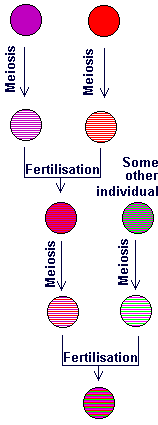
|
Each individual is unique but is also a mix. We are "half like" (½) each of our (two) parents, a "quarter like" (¼) each of our (four) grandparents, an "eight like" (1/8) each of our (eight) great grandparents, a "sixteenth like" (1/16) each of our (sixteen) great, great grandparents, etc. This genetic heritage extends back for many millions of years! (Perhaps billions of years, depending on how you define things.)
But meiosis is not "simply" a halving of the genetic materials. Chromosomes have to be distributed in a precise manner to make sure that a full set (n) of chromosomes is in the gametes.
The "trick" to meiosis is to understand that the DNA
is replicated only once, during S phase in interphase, BUT the
nucleus divides TWICE!
It is also important to understand that a diploid cell, containing
its normal 2n complement of chromosomes, is composed of a set
(n) from each parent and they can be thought of as pairs of chromosomes.
Let's use the human genome as an example. You have 46 chromosomes
(23 pairs) in your "normal" cells. You have two #1 chromosomes - one from your father and one from your mother.
The chromosomes from your father are called paternal and
can be abbreviated as "P" while those from your mother
are called maternal and abbreviated as "M". [I remember this as "Pop and Mom".  ] ]
So, you have two #1 chromosomes, #2 chromosomes, two #3 chromosomes, etc. - one each from "pop" and one each from "mom". We call these pairs homologous pairs (of chromosomes). They are identical in size and appearance. [The "sex chromosomes" are an exception that we will talk about in a later course.] |
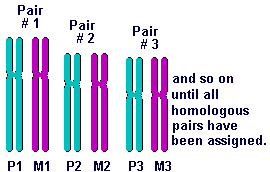
|
Homologous pairs look identical because they carry the same genes in the same order. [In point of fact, the genes are very similar but rarely identical. More on that in a future lesson.]
Now a little reminder about mitosis. At the end of interphase the DNA has been duplicated so we see the familiar X-shaped pattern of a two-chromatid chromosome during the subsequent nuclear division. This pattern is called a dyad. During mitosis dyads line up at the metaphase plate and the division of the dyad (X-shaped chromosome) during anaphase "creates" the new chromosomes.
Meiosis is different because there are two divisions and the chromosomes
line up differently at the two different metaphase plates.
You'll be happy to know that we use the same names for the
phases (prophase, metaphase, anaphase and telophase) because the
phases are almost identical. You can use the same identification
features you learned earlier for mitosis to identify all the phases
of meiosis.
The only thing we do differently with meiosis is we add a I (one)
or II (two) to the end of each phase to remind us which division
of meiosis we are talking about. The first division is meiosis
I (and it contains prophase I, metaphase I, anaphase I and
telophase I) and the second meiotic division is meiosis II
(and it contains prophase II, etc.).
So, let's go through meiosis!
As you know the cell enters nuclear division after having successfully
duplicated its DNA during S phase of interphase.
Prophase I looks identical to mitotic prophase - chromosomes decondense,
the nuclear membrane breaks down and spindle fibers tug the chromosomes
around as they line them up along the metaphase plate.
|
In fact, very important events occur in prophase I but they are
difficult to see. During prophase I the chromosomes are matched
in homologous pairs and they swap genetic material between themselves!
We'll come back to the "swapping" in the next lesson. For now, let's consider this pairing. When the two homologous pairs are aligned, side-by-side, we call the pair a tetrad. Therefore, a tetrad is composed of two chromosomes - one maternal (M) and one paternal (P). A tetrad will have two centromeres and four chromatids because it is made from two chromosomes. Recall that a dyad was a single chromosome so a tetrad is composed of two dyads. |

|
The creation of tetrads occurs in prometaphase I (late prophase I) but its importance becomes obvious in metaphase I of meiosis.
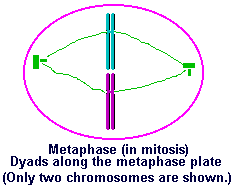
|
Recall that in mitosis (on the left) all the chromosomes (dyads) are aligned
along the metaphase plate.
Contrast that with metaphase I of meiosis I (on the right). Here tetrads are aligned along the metaphase plate! Notice that the M and P pairs in the tetrad can be aligned to either side. [What I mean is you don't get all the paternal chromosomes on one side and all the maternal chromosomes on the other. It's random.] |
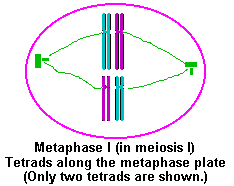
|
Using a human cell as an example, a mitosis metaphase will show 46 dyads (chromosomes) along the metaphase plate but in metaphase I (of meiosis I) the metaphase plate contains 23 tetrads - for a total of 46 chromosomes (dyads) but arranged in pairs (tetrads)!
After metaphase I comes anaphase I.
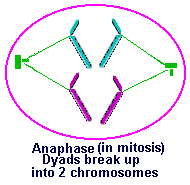
|
You will recall that in mitosis (on the left) the anaphase is the stage at which
the chromatids of the chromosomes (dyads) are separated and we
get two new chromosomes.
In anaphase I of meiosis I (on the right) each tetrad separates into two dyads! No chromosomes are "pulled apart" so no new chromosomes are formed. Instead, at anaphase I, the paternal and maternal partners are separated. Notice that each pair is separated in a random direction. This is NOT the equal division of nuclear materials and it is NOT going to produce identical nuclei! |
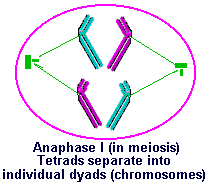
|
Using a human cell as an example, at mitosis the anaphase creates
92 chromosomes from the 92 chromatids in 46 dyads.
Contrast that with anaphase I where the chromosomes are not split. Instead
the 23 tetrads, each made of two dyads, are separated into two
chromosomes (dyads) when dragged to the poles. That means
each pole will receive 23 chromosomes not 46!
Anaphase I is the point at which the reduction division occurs!
|
This is also the point at which a great deal of diversity is created.
Recall that the direction each chromosome in the tetrad goes (left
or right) is random so each tetrad separation is an "independent
event".
Let's say that M1 went left so P1 must go right. M2 can go right or left and P2 will just go the opposite way of M2.
In my drawing I show only two pairs of chromosomes and, as you can see, there are two different possibilities that give four different nuclei when the division is completed.
Summary: due to the variety of possible arrangements of the tetrads, you can produce millions of different kinds of gametes! |
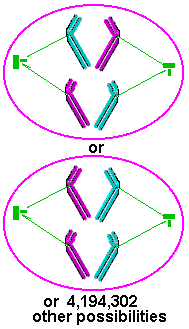
|
After anaphase comes telophase. Note that after telophase I the two newly formed daughter nuclei will be haploid (contain n chromosomes). [Recall that a cell will have two diploid (2n) nuclei after telophase of mitosis. Right? That's an important difference!]
Some species do not have a "proper" telophase I with
all the rebuilding of nuclear membranes and decondensing of chromosomes.
That's because the next division is coming up so quickly that
there is no need to bother with all that work - rebuilding the nuclear membrane only to soon break it up again is a waste of energy. (That work would just be reversed in the next prophase!)
Regardless of the "quality" of telophase I it is always
followed by cytokinesis. That gives us two daughter cells that
are haploid.
The second division follows without any intervening interphase
so there is no S phase and, most importantly, no duplication of
genetic materials. That means both the daughter cells enter meiosis
II as haploid cells. They have half the chromosomal complement
of "normal" cells.
However, the centrosome has duplicated and that is important
because you need two centrosomes in the next division to guide
the chromosomes.
Meiosis II is identical to mitosis except now there will be only half as many chromosomes to deal with. Both of the daughter cells produced from the cytokinesis, which occurred after meiosis I, will often go through meiosis II at the same time. Rather than show you both cells and clutter up the diagrams I will illustrate only one.
Prophase II is unremarkable. If there had been a proper telophase I, this second prophase (prophase II) will cause the chromosomes to recondense and the new nuclear membrane to break down. New spindle fibers connect to the chromosomes but this time they grab the chromosomes from both sides, using both kinetochores, so prometaphase II is like prometaphase of mitosis.
|
More importantly, metaphase II and anaphase II are identical to
metaphase and anaphase in of mitosis except there are only n
chromosomes instead of 2n.
At metaphase II the chromosomes line up along the metaphase plate as a string of dyads - 23 in the case of humans. At anaphase II the chromosomes are pulled apart into separate chromatids, which are now chromosomes - 46 of them. The number of chromosomes after anaphase is twice what it was moments before because the number of chromosomes (centromeres) has doubled due to the chromosome being pulled in half - just like in mitotic anaphase.
Technically, this anaphase II cell has "returned" to
a diploid number! |
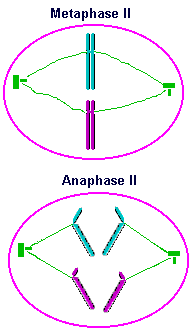
|
Now that meiosis II is over the last cytokinesis occurs and the cell divides its two haploid
nuclei between the two new cells. The end result is two cells
each with a haploid nucleus. Recall that both daughter cells from
meiosis I go through meiosis II, so we end up with a total of
four haploid (n) daughter cells from one diploid (2n) mother cell. [Phew!  ]
]
| This diagram summarizes the process of meioses I and II and two cytokinesis processes. Not only is this a good summary - it also a good opportunity for you to practice your understanding of chromosome counts. |

|
Carefully look at the details in this diagram and understand them. Pay attention to the uses of the words "cell" and "nuclei" as well as "diploid" and "haploid" as you follow the cells' progress through this chart and through the SAQs.
 and
and  licensed under a Creative Commons Attribution-ShareAlike 4.0 International License.
licensed under a Creative Commons Attribution-ShareAlike 4.0 International License.
| Table of Contents | Homepage | How to get a FREE copy of the entire course (hypertextbook) | Frequently Asked Questions |